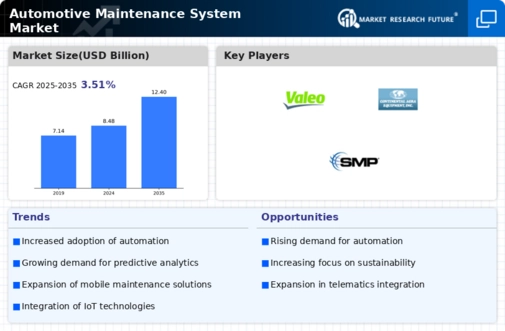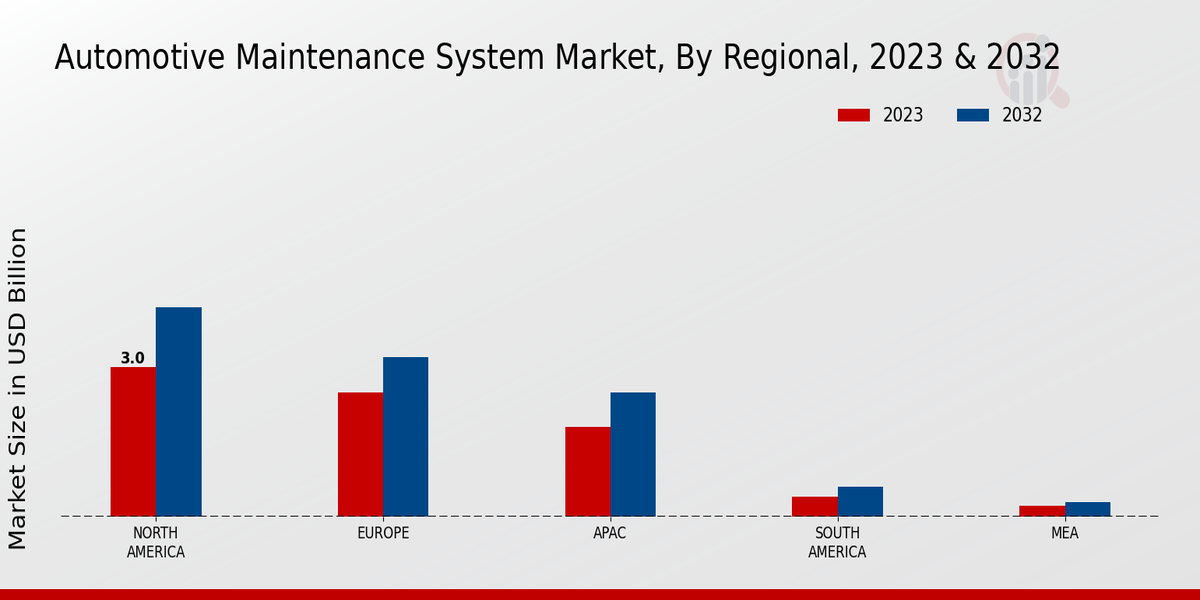Regulatory Compliance
Stringent regulations regarding vehicle emissions and safety standards are driving the Global Automotive Maintenance System Market Industry. Governments worldwide are implementing policies that require regular vehicle inspections and maintenance to ensure compliance with environmental and safety regulations. This regulatory landscape compels vehicle owners and service providers to adopt comprehensive maintenance systems that can track compliance and facilitate necessary repairs. As a result, the market is expected to grow at a CAGR of 3.52% from 2025 to 2035, highlighting the critical role of maintenance systems in adhering to these regulations and promoting sustainable automotive practices.
Growing Vehicle Ownership
The increasing number of vehicles globally is a primary driver for the Global Automotive Maintenance System Market Industry. As more individuals acquire personal and commercial vehicles, the demand for maintenance services escalates. In 2024, the market is projected to reach 8.48 USD Billion, reflecting the necessity for efficient maintenance systems to manage this growing fleet. This trend is particularly evident in emerging economies, where vehicle ownership rates are surging. Consequently, automotive maintenance systems are becoming essential for ensuring vehicle longevity and safety, thereby enhancing the overall customer experience.
Market Growth Projections
The Global Automotive Maintenance System Market Industry is poised for substantial growth, with projections indicating a market value of 8.48 USD Billion in 2024 and an increase to 12.4 USD Billion by 2035. This growth trajectory suggests a robust demand for automotive maintenance solutions, driven by factors such as increased vehicle ownership, technological advancements, and regulatory compliance. The anticipated CAGR of 3.52% from 2025 to 2035 further emphasizes the market's potential. These figures illustrate the dynamic nature of the industry and the ongoing evolution of maintenance systems to meet the needs of a growing automotive landscape.
Technological Advancements
Technological innovations are reshaping the Global Automotive Maintenance System Market Industry. The integration of advanced diagnostics, telematics, and predictive maintenance technologies allows for more efficient and effective vehicle servicing. These systems enable real-time monitoring of vehicle health, which can lead to reduced downtime and improved service quality. As a result, automotive maintenance systems are increasingly being adopted by service providers to enhance operational efficiency. The anticipated growth from 2024 to 2035, with a market value of 12.4 USD Billion, underscores the importance of these technologies in meeting the evolving demands of vehicle maintenance.
Increased Focus on Preventive Maintenance
There is a growing emphasis on preventive maintenance within the Global Automotive Maintenance System Market Industry. Vehicle owners are increasingly recognizing the benefits of regular maintenance in extending vehicle lifespan and enhancing performance. This shift is driven by the rising costs associated with major repairs and the desire to avoid unexpected breakdowns. Maintenance systems that facilitate scheduled servicing and provide reminders are becoming more popular among consumers. This trend is likely to contribute to the market's growth, as more individuals seek to invest in systems that promote proactive vehicle care and maintenance.
Expansion of E-commerce in Automotive Services
The rise of e-commerce platforms is transforming the Global Automotive Maintenance System Market Industry. Online service booking and mobile applications are making it easier for consumers to access maintenance services. This trend allows service providers to reach a broader audience and streamline their operations. The convenience of scheduling maintenance online is appealing to modern consumers, who value efficiency and accessibility. As the market adapts to these changes, the integration of e-commerce solutions is expected to drive growth, reflecting the evolving landscape of automotive services in the digital age.





